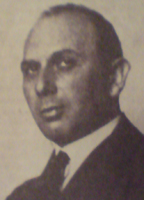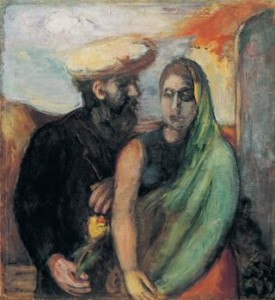Oskar Herman facts for kids
Quick facts for kids
Oskar Herman
|
|
|---|---|
 |
|
| Born | 17 March 1886 Zagreb, Kingdom of Croatia-Slavonia, Austria-Hungary
|
| Died | 22 January 1974 (aged 87) Zagreb, SR Croatia, SFR Yugoslavia
|
| Nationality | Croatian |
| Education | Zagreb, Munich |
| Known for | painting |
|
Notable work
|
paintings in oils and watercolour, drawings |
| Movement | colourist expressionism, modern |
Oskar Herman (born 1886, died 1974) was an important Croatian painter. He was part of a special group of Croatian artists called the Munich Circle. This group had a big impact on modern art in Croatia.
Contents
Life Story of Oskar Herman
Oskar Herman was born in Zagreb on March 17, 1886. His family was Croatian Jewish. His father passed away when Oskar was only four years old.
Early Art Studies
Even though he first went to business school in Zagreb, Oskar loved drawing and painting. He decided to study art at a painting school in Zagreb. In 1904, he moved to Munich, Germany. There, he studied with a famous teacher named Anton Ažbe.
In 1905, Oskar joined the Academy of Fine Arts in Munich. He studied there until 1910. At that time, Munich was a very important city for art in Europe. Many different art styles were popular there, like Realism (showing things as they really are) and Post-Impressionism (using bright colors and brushstrokes).
Returning to Croatia
When World War I started in 1914, Herman came back to Zagreb. He served in the army in Zagreb from 1915 to 1918. After the war, he returned to Munich and lived there until 1933. He also spent some time in Berlin and Paris.
In 1933, he moved back to Zagreb because of the rise of Nazism in Germany. While he lived in Munich, he often showed his art in exhibitions and had some success.
During World War II
During World War II, Herman joined the Partisan forces. He was held in a special camp in Italy from 1942 to 1944. After he was released, he joined a group of artists in a place called Cozzano.
In 1944, Herman returned to Croatia and rejoined the Partisans. In 1945, he started working at the Modern Gallery in Zagreb. He was a curator, which means he helped take care of the art collection. He worked there until he retired in 1954.
Later Years and Recognition
After retiring, Oskar Herman had a big exhibition of his work in 1954. Later, in 1971, he had another major show at the Art Pavilion. Oskar Herman was a quiet artist who didn't seek much attention. Because of this, his art took a while to be fully understood and appreciated.
He passed away on January 22, 1974, in Zagreb. He was buried in the Mirogoj Cemetery.
Oskar Herman's Art Style
Oskar Herman was a key member of the Munich Circle. His early paintings greatly influenced Croatian art in the first half of the 1900s. He lived the longest among the Munich Circle artists, which gave him more time to grow as a painter. However, he was not as well-known in Croatia for a long time.
Recent art shows have helped people understand his work better. These shows displayed many of his drawings from his time in Munich (1906–1933). While in Munich, Herman was inspired by ideas about "pure visibility" in art. He also admired older artists like Giorgione and Tintoretto.
Herman was a unique artist. He followed his own artistic ideas and wasn't much affected by other art trends. By the 1920s, he was known for being a bit of a loner. He used symbolism in his art even before the expressionism movement became popular.
His paintings became more and more expressive over time. He often painted people and their inner feelings. His early watercolours used strong, bright colors. This led to his own special style of expressionist color. After 1925, his art also started to show a sense of worry about future problems.
One of Herman's paintings, Dva stabla pod brijegom (Two Trees at the Foot of a Hill) from 1973, was even featured on a Croatian stamp in 2008.
Notable Works
- Dva stabla pod brijegom (Two Trees at the Foot of a Hill), 1973
Art Exhibitions
Oskar Herman's art has been shown in many places.
Solo Exhibitions
- 1963: Galerija Umjetnina Split, Split
- 1994: Gallery of Fine Arts, Osijek
- 2006: Museum of Modern Art Dubrovnik, Dubrovnik (Paintings and drawings from 1906–1974)
- 2007: Glyptotheque – Sculpture Museum, Zagreb (Drawings)
- 2010: Art Pavilion, Zagreb (A large show with 340 pieces, from his earliest work to his last painting)
Group Exhibitions
- 1973: Paintings of the Munich Circle – Art Pavilion Zagreb
- 2006: Croatian Collection – Museum of Contemporary Art Skopje
- 2007: From the Gallery's Holdings – Museum of Modern Art Dubrovnik
- 2008: From the Museum's Holdings – Museum of Modern Art Dubrovnik
- 2009–10: Zagreb – Munich: Croatian painters and the Academy of Art in Munich – Art Pavilion in Zagreb
Where to See His Art (Public Collections)
You can find Oskar Herman's paintings in these museums:
- Museum of Modern Art, Dubrovnik, Croatia
- Museum of Modern and Contemporary Art, Rijeka, Croatia
- Rovinj Heritage Museum, Rovinj, Croatia
- Art Gallery, Split, Croatia
- Museum of Contemporary Art, Zagreb, Croatia
- Museum of Contemporary Art Skopje, Skopje, Macedonia


